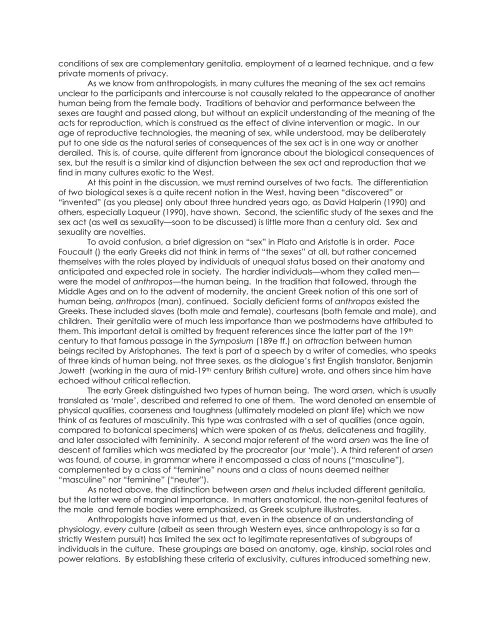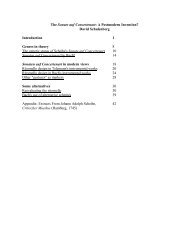SEVEN PAPERS ON EXISTENTIAL ANALYSIS ... - Wagner College
SEVEN PAPERS ON EXISTENTIAL ANALYSIS ... - Wagner College
SEVEN PAPERS ON EXISTENTIAL ANALYSIS ... - Wagner College
You also want an ePaper? Increase the reach of your titles
YUMPU automatically turns print PDFs into web optimized ePapers that Google loves.
conditions of sex are complementary genitalia, employment of a learned technique, and a few<br />
private moments of privacy.<br />
As we know from anthropologists, in many cultures the meaning of the sex act remains<br />
unclear to the participants and intercourse is not causally related to the appearance of another<br />
human being from the female body. Traditions of behavior and performance between the<br />
sexes are taught and passed along, but without an explicit understanding of the meaning of the<br />
acts for reproduction, which is construed as the effect of divine intervention or magic. In our<br />
age of reproductive technologies, the meaning of sex, while understood, may be deliberately<br />
put to one side as the natural series of consequences of the sex act is in one way or another<br />
derailed. This is, of course, quite different from ignorance about the biological consequences of<br />
sex, but the result is a similar kind of disjunction between the sex act and reproduction that we<br />
find in many cultures exotic to the West.<br />
At this point in the discussion, we must remind ourselves of two facts. The differentiation<br />
of two biological sexes is a quite recent notion in the West, having been “discovered” or<br />
“invented” (as you please) only about three hundred years ago, as David Halperin (1990) and<br />
others, especially Laqueur (1990), have shown. Second, the scientific study of the sexes and the<br />
sex act (as well as sexuality—soon to be discussed) is little more than a century old. Sex and<br />
sexuality are novelties.<br />
To avoid confusion, a brief digression on “sex” in Plato and Aristotle is in order. Pace<br />
Foucault () the early Greeks did not think in terms of “the sexes” at all, but rather concerned<br />
themselves with the roles played by individuals of unequal status based on their anatomy and<br />
anticipated and expected role in society. The hardier individuals—whom they called men—<br />
were the model of anthropos—the human being. In the tradition that followed, through the<br />
Middle Ages and on to the advent of modernity, the ancient Greek notion of this one sort of<br />
human being, anthropos (man), continued. Socially deficient forms of anthropos existed the<br />
Greeks. These included slaves (both male and female), courtesans (both female and male), and<br />
children. Their genitalia were of much less importance than we postmoderns have attributed to<br />
them. This important detail is omitted by frequent references since the latter part of the 19 th<br />
century to that famous passage in the Symposium (189e ff.) on attraction between human<br />
beings recited by Aristophanes. The text is part of a speech by a writer of comedies, who speaks<br />
of three kinds of human being, not three sexes, as the dialogue’s first English translator, Benjamin<br />
Jowett (working in the aura of mid-19 th century British culture) wrote, and others since him have<br />
echoed without critical reflection.<br />
The early Greek distinguished two types of human being. The word arsen, which is usually<br />
translated as ‘male’, described and referred to one of them. The word denoted an ensemble of<br />
physical qualities, coarseness and toughness (ultimately modeled on plant life) which we now<br />
think of as features of masculinity. This type was contrasted with a set of qualities (once again,<br />
compared to botanical specimens) which were spoken of as thelus, delicateness and fragility,<br />
and later associated with femininity. A second major referent of the word arsen was the line of<br />
descent of families which was mediated by the procreator (our ‘male’). A third referent of arsen<br />
was found, of course, in grammar where it encompassed a class of nouns (“masculine”),<br />
complemented by a class of “feminine” nouns and a class of nouns deemed neither<br />
“masculine” nor “feminine” (“neuter”).<br />
As noted above, the distinction between arsen and thelus included different genitalia,<br />
but the latter were of marginal importance. In matters anatomical, the non-genital features of<br />
the male and female bodies were emphasized, as Greek sculpture illustrates.<br />
Anthropologists have informed us that, even in the absence of an understanding of<br />
physiology, every culture (albeit as seen through Western eyes, since anthropology is so far a<br />
strictly Western pursuit) has limited the sex act to legitimate representatives of subgroups of<br />
individuals in the culture. These groupings are based on anatomy, age, kinship, social roles and<br />
power relations. By establishing these criteria of exclusivity, cultures introduced something new,















